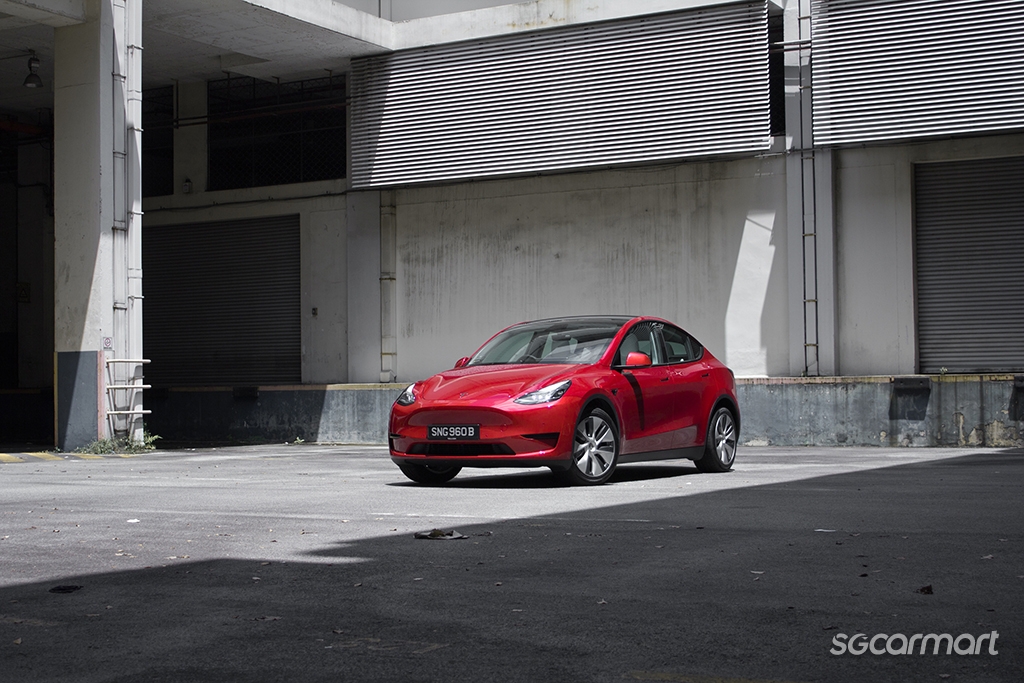The growing SUV trend: What the numbers tell us
04 Nov 2024|3,838 views
In recent years, we've talked a lot about the growing appetite for SUVs - driven by customer demand, and matched by manufacturer supply.
We've seen it in the rapid proliferation of SUV models from just about every brand you can name, including brands that never previously made SUVs. And, we've certainly also seen the rapid increase of SUVs on our roads.
We all probably individually and collectively know and acknowledge this to be true. But just how exactly is the trend growing? Well, there are numbers to tell us.
The statistics
Looking at LTA's New Registration of Cars by Make statistics, new car sales are broken down by body type. The statistics are available from 2015:
| Year | HB | Sedan | MPV/STW | SUV | Total | HB % | Sedan % | MPV/STW % | SUV % |
| 2015 | 7,146 | 25,806 | 7,775 | 15,329 | 57,589 | 12.4 | 44.8 | 13.5 | 26.6 |
| 2016 | 9,901 | 32,488 | 15,525 | 27,912 | 87,504 | 11.3 | 37.1 | 17.7 | 31.9 |
| 2017 | 11,833 | 33,910 | 16,423 | 27,172 | 91,922 | 12.9 | 36.9 | 17.9 | 29.6 |
| 2018 | 11,542 | 30,781 | 13,852 | 21,971 | 80,281 | 14.4 | 38.3 | 17.3 | 27.4 |
| 2019 | 12,239 | 26,905 | 11,465 | 19,561 | 72,344 | 16.9 | 37.2 | 15.8 | 27 |
| 2020 | 6,798 | 15,119 | 6,272 | 14,914 | 44,465 | 15.3 | 34 | 14.1 | 33.5 |
| 2021 | 5,819 | 14,972 | 6,348 | 16,739 | 45,442 | 12.8 | 32.9 | 14 | 36.8 |
| 2022 | 3,120 | 9,109 | 4,881 | 12,337 | 30,939 | 10.1 | 29.4 | 15.8 | 39.9 |
| 2023 | 2,542 | 6,579 | 5,475 | 14,405 | 30,225 | 8.4 | 21.8 | 18.1 | 47.7 |
|
2024 (9 months) |
1,689 | 7,151 | 4,649 | 16,131 | 30,567 | 5.5 | 23.4 | 15.2 | 52.8 |
| 2024 (extrapolated) | 2,252 | 9,535 | 6,199 | 21,508 | 40,756 | 5.5 | 23.4 | 15.2 | 52.8 |
There are two things worth considering - absolute numbers, and percentage.
Overall, the total number of cars sold per year has dropped significantly - it peaked in 2017 at over 91,000, and has significantly dropped to about 30,000 in the past two years (not surprising considering the shrinking COE supply and accompanying sky-high COE premiums).
However, if we look at the percentages, we can immediately see that the SUVs category has been growing significantly in market share of new car sales - from 26.6% in 2015 to 47.7% in 2023. In the first nine months of 2024, SUV sales actually exceeded 50% - this means that every one in two new cars sold is an SUV.
The segment that is taking the hardest absolute hit is sedans. Where it was previously the most popular car type being sold, accounting for 44.8% in 2015, it has tumbled to the low 20s - just 21.8% in 2023, and a projected 23.4% in 2024. That's basically half what it was.
Hatchbacks, too, are seeing a drop in popularity, falling from a high of 16.9% to a projected 5.5% in 2024. This represents the highest percentage decrease.
MPVs have held relatively steady in popularity. (The segment was previously grouped together with stationwagons. LTA has separated them since 2022, but the stationwagon numbers are very low. We have grouped them together to allow consistency in calculations.) Overall sales share has fluctuated between around 13% to 18%, and it currently still holds about 15% of the overall sales volume.
The inflection point
Back to SUVs, though. A key inflection point was in 2020, where SUV sales more-or-less matched sedan sales at about 34% each. What happened in 2020? Well, COVID, obviously.
That likely accelerated an already growing trend - private-hire services, of which many vehicles were of the SUV-kind. Grab's acquisition of Uber's SEA operations in 2018 saw a further consolidation of ride-hailing services, and its continued expansion brought with it new impetus for more blue-labelled SUVs on our roads. The COVID pandemic, and commuters hygienic preference for cars rather than public transport, can be seen as further increasing SUV-demand.
Furthermore, many brands were also delivering new SUV products to meet shifting customer preferences. Despite the overall car sales falling 39% in 2020, brands including Audi, Land Rover, MG (a new entrant into the market), Mazda and Mercedes-Benz all saw SUV sales increase year-on-year. Both Toyota (including Lexus) and Volvo saw SUV sales dip slightly, but relative to market contraction still represented growth in the SUV segment.
2019-2020 also saw market arrivals of new SUV models like the Mercedes-Benz GLB-Class, Lexus UX and MG HS. Additionally, new generation models of popular SUVs like the Audi Q3, Toyota Harrier and Mercedes-Benz GLA-Class meant that customers had increasing breadth of choices.
Since then, SUV sales have been on a one-way trajectory: Upwards. Year-on-year, the percentage of SUVs sold relative to the total sales volume has increased, and that shows no sign of easing up.
In 2023, the number reached close to 50%, and 2024 is set to exceed 50% (it's currently at 52.8%). The BYD Atto 3 is currently the best-selling car in Singapore, while SUVs from the likes of Mercedes-Benz, Toyota (including Lexus) and Tesla continue to be popular. SUV sales in 2024 are projected to be over 21,000. In absolute numbers, that's similar to 2018, but in 2018 the total new car sales was two-fold of what's projected for 2024.
Looking at the new car landscape, we can also see SUVs dominating. Of the 514 new car models currently listed for sale on the Sgcarmart New Car Page, 219 are of the SUV type. That's about 43%.
For some additional context, of the 123 new car insertions in 2015, 30 were SUVs - 24%. 35 out of 145 new car insertions in 2017 were SUVs - also 24%.
In 2020, 81 new car listings were inserted, of which 36 were SUVs - 44%. In 2021, 29 of the 75 new car listing insertions were SUVs - 39%. The uptick is clear to see.
Looking ahead
Where does this all lead?
The statistics don't lie - there has been a clear and obvious shift in new car sales from sedans to SUVs, bolstered also by a growing supply of SUV models from car manufacturers.
Looking forward, and forecasting based on these available statistics, the SUV percentage of new car sales could hit 60% in 2029, and 70% in 2033.
Whether this pace of SUV growth will hold steady is hard to fully evaluate. But a few factors are worth taking into consideration:
- As brands increasingly look to electrify their lineups (and in some cases, brands having committed to going fully electric), SUVs will likely be a notable part of that electrification strategy. Generally, SUVs are more conducive towards electrification, given their slightly more flexible packaging to accommodate large batteries.
- Just in 2024 alone, we've seen a significant number of new brands entering the market - almost all of them with all-electric SUV models
- Singapore's population is aging, and naturally, so is the car-driving demographic. Given their relatively higher hip point and more convenient ingress/egress, SUVs may become increasingly popular among older drivers.
- The blurring lines between body types (especially the hatchback/SUV/MPV segments), combined with some opaqueness about how LTA exactly classifies models, could see changing statistics purely on technicalities.
Will the SUV segment will continue to see the persistent year-on-year growth that it has been experiencing? It's hard to definitively say (one would think there may be some point of eventual market saturation). But one thing's for sure, SUVs are here to stay.
In recent years, we've talked a lot about the growing appetite for SUVs - driven by customer demand, and matched by manufacturer supply.
We've seen it in the rapid proliferation of SUV models from just about every brand you can name, including brands that never previously made SUVs. And, we've certainly also seen the rapid increase of SUVs on our roads.
We all probably individually and collectively know and acknowledge this to be true. But just how exactly is the trend growing? Well, there are numbers to tell us.
The statistics
Looking at LTA's New Registration of Cars by Make statistics, new car sales are broken down by body type. The statistics are available from 2015:
| Year | HB | Sedan | MPV/STW | SUV | Total | HB % | Sedan % | MPV/STW % | SUV % |
| 2015 | 7,146 | 25,806 | 7,775 | 15,329 | 57,589 | 12.4 | 44.8 | 13.5 | 26.6 |
| 2016 | 9,901 | 32,488 | 15,525 | 27,912 | 87,504 | 11.3 | 37.1 | 17.7 | 31.9 |
| 2017 | 11,833 | 33,910 | 16,423 | 27,172 | 91,922 | 12.9 | 36.9 | 17.9 | 29.6 |
| 2018 | 11,542 | 30,781 | 13,852 | 21,971 | 80,281 | 14.4 | 38.3 | 17.3 | 27.4 |
| 2019 | 12,239 | 26,905 | 11,465 | 19,561 | 72,344 | 16.9 | 37.2 | 15.8 | 27 |
| 2020 | 6,798 | 15,119 | 6,272 | 14,914 | 44,465 | 15.3 | 34 | 14.1 | 33.5 |
| 2021 | 5,819 | 14,972 | 6,348 | 16,739 | 45,442 | 12.8 | 32.9 | 14 | 36.8 |
| 2022 | 3,120 | 9,109 | 4,881 | 12,337 | 30,939 | 10.1 | 29.4 | 15.8 | 39.9 |
| 2023 | 2,542 | 6,579 | 5,475 | 14,405 | 30,225 | 8.4 | 21.8 | 18.1 | 47.7 |
|
2024 (9 months) |
1,689 | 7,151 | 4,649 | 16,131 | 30,567 | 5.5 | 23.4 | 15.2 | 52.8 |
| 2024 (extrapolated) | 2,252 | 9,535 | 6,199 | 21,508 | 40,756 | 5.5 | 23.4 | 15.2 | 52.8 |
There are two things worth considering - absolute numbers, and percentage.
Overall, the total number of cars sold per year has dropped significantly - it peaked in 2017 at over 91,000, and has significantly dropped to about 30,000 in the past two years (not surprising considering the shrinking COE supply and accompanying sky-high COE premiums).
However, if we look at the percentages, we can immediately see that the SUVs category has been growing significantly in market share of new car sales - from 26.6% in 2015 to 47.7% in 2023. In the first nine months of 2024, SUV sales actually exceeded 50% - this means that every one in two new cars sold is an SUV.
The segment that is taking the hardest absolute hit is sedans. Where it was previously the most popular car type being sold, accounting for 44.8% in 2015, it has tumbled to the low 20s - just 21.8% in 2023, and a projected 23.4% in 2024. That's basically half what it was.
Hatchbacks, too, are seeing a drop in popularity, falling from a high of 16.9% to a projected 5.5% in 2024. This represents the highest percentage decrease.
MPVs have held relatively steady in popularity. (The segment was previously grouped together with stationwagons. LTA has separated them since 2022, but the stationwagon numbers are very low. We have grouped them together to allow consistency in calculations.) Overall sales share has fluctuated between around 13% to 18%, and it currently still holds about 15% of the overall sales volume.
The inflection point
Back to SUVs, though. A key inflection point was in 2020, where SUV sales more-or-less matched sedan sales at about 34% each. What happened in 2020? Well, COVID, obviously.
That likely accelerated an already growing trend - private-hire services, of which many vehicles were of the SUV-kind. Grab's acquisition of Uber's SEA operations in 2018 saw a further consolidation of ride-hailing services, and its continued expansion brought with it new impetus for more blue-labelled SUVs on our roads. The COVID pandemic, and commuters hygienic preference for cars rather than public transport, can be seen as further increasing SUV-demand.
Furthermore, many brands were also delivering new SUV products to meet shifting customer preferences. Despite the overall car sales falling 39% in 2020, brands including Audi, Land Rover, MG (a new entrant into the market), Mazda and Mercedes-Benz all saw SUV sales increase year-on-year. Both Toyota (including Lexus) and Volvo saw SUV sales dip slightly, but relative to market contraction still represented growth in the SUV segment.
2019-2020 also saw market arrivals of new SUV models like the Mercedes-Benz GLB-Class, Lexus UX and MG HS. Additionally, new generation models of popular SUVs like the Audi Q3, Toyota Harrier and Mercedes-Benz GLA-Class meant that customers had increasing breadth of choices.
Since then, SUV sales have been on a one-way trajectory: Upwards. Year-on-year, the percentage of SUVs sold relative to the total sales volume has increased, and that shows no sign of easing up.
In 2023, the number reached close to 50%, and 2024 is set to exceed 50% (it's currently at 52.8%). The BYD Atto 3 is currently the best-selling car in Singapore, while SUVs from the likes of Mercedes-Benz, Toyota (including Lexus) and Tesla continue to be popular. SUV sales in 2024 are projected to be over 21,000. In absolute numbers, that's similar to 2018, but in 2018 the total new car sales was two-fold of what's projected for 2024.
Looking at the new car landscape, we can also see SUVs dominating. Of the 514 new car models currently listed for sale on the Sgcarmart New Car Page, 219 are of the SUV type. That's about 43%.
For some additional context, of the 123 new car insertions in 2015, 30 were SUVs - 24%. 35 out of 145 new car insertions in 2017 were SUVs - also 24%.
In 2020, 81 new car listings were inserted, of which 36 were SUVs - 44%. In 2021, 29 of the 75 new car listing insertions were SUVs - 39%. The uptick is clear to see.
Looking ahead
Where does this all lead?
The statistics don't lie - there has been a clear and obvious shift in new car sales from sedans to SUVs, bolstered also by a growing supply of SUV models from car manufacturers.
Looking forward, and forecasting based on these available statistics, the SUV percentage of new car sales could hit 60% in 2029, and 70% in 2033.
Whether this pace of SUV growth will hold steady is hard to fully evaluate. But a few factors are worth taking into consideration:
- As brands increasingly look to electrify their lineups (and in some cases, brands having committed to going fully electric), SUVs will likely be a notable part of that electrification strategy. Generally, SUVs are more conducive towards electrification, given their slightly more flexible packaging to accommodate large batteries.
- Just in 2024 alone, we've seen a significant number of new brands entering the market - almost all of them with all-electric SUV models
- Singapore's population is aging, and naturally, so is the car-driving demographic. Given their relatively higher hip point and more convenient ingress/egress, SUVs may become increasingly popular among older drivers.
- The blurring lines between body types (especially the hatchback/SUV/MPV segments), combined with some opaqueness about how LTA exactly classifies models, could see changing statistics purely on technicalities.
Will the SUV segment will continue to see the persistent year-on-year growth that it has been experiencing? It's hard to definitively say (one would think there may be some point of eventual market saturation). But one thing's for sure, SUVs are here to stay.
Thank You For Your Subscription.




































